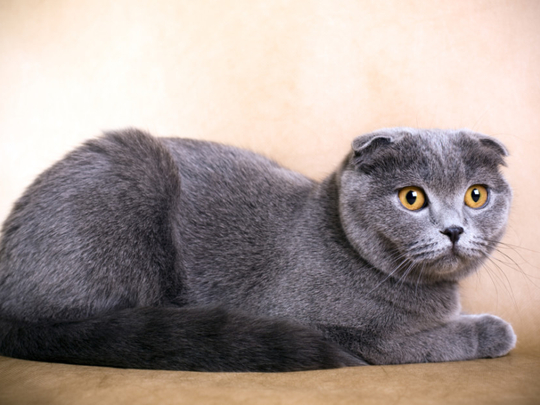
Dubai: Despite animal breeding being restricted in the UAE, demand for popular feline breeds such as the Scottish Fold cat are on the increase, with little awareness among pet lovers about the genetic conditions they suffer from.
The Scottish Fold cat, a breed of domestic cat, suffers from a form of dwarfism and carries a natural dominant-gene mutation that affects bones and cartilage in their body.
This condition causes their ears to fold forward and downwards, giving them a ‘teddy-bear-like’ appearance and making them one of the most popular breeds among their feline friends.
However, this condition can also leave them crippled by the young age of four.
Speaking to Gulf News, Dr Sara Elliott from the British Veterinary Hospital in Dubai, pointed out that due to UAE laws preventing breeding of animals except through registered breeders, most Scottish Fold cats are imported from abroad.
“It is against the law for a private individual to sell a pet or receive money for it here in the UAE. However, we do see many Scottish Fold cats, as well as Persian cats and British Blue cats here at the hospital,” she said.
Through social media, people are putting popular feline breeds up for sale, and charging as high as Dh5,000 for Scottish Fold cats.
Many online posts include appealing close-up pictures of Scottish Fold cats highlighting their large eyes and often described as “cute,” and “sweet.”
Gudrun Ravetz, president of the British Veterinary Association, also described the cat breed as “cute”, when speaking to the BBC.
“These cats have become so popular on social media and with celebrities … People are wanting to have these cats because of that, but unfortunately it is another example of us prioritising how a pet looks rather than their quality of life,” she told the BBC.
Celebrities such as Ed Sheeran, Taylor Swift, and Kirsten Dust have posted images with their Scottish Fold cats on social media.
However, what many people are unaware of is continuing to breed this feline for the “purpose of popularity rather than welfare” almost guarantees a difficult life for the pet and his owner.
“With Scottish Fold cats, the bones and cartilage do not form properly and as a result they have the overly large head, short face and jaw. They also have short, bandy legs and thick immobile tails. The cartilage is not strong enough to work as a shock absorber in the joints and as such it wears out very quickly leading to severe arthritis and spinal issues,” explained Elliott.
She explained that the Scottish Fold cat is generally bred with either the Persian cat resulting in a fluffier kitten, or the British Blue cat, which often has a rounder face.
“The Scottish Fold cat is a mixture of two of the three. Unfortunately, the Persian cat often suffers from the polycystic disease, so you are often breeding a known genetic mutation with a likely mutation, and the British Blue is well known for genetic heart disease,” said Elliott.
This means the Scottish Fold cat combines a known mutation with likely mutations, resulting in the breed being susceptible to polycystic kidney disease (PKD), heart disease, and degenerative joint disease, most commonly affecting the tail, ankles, and knees.
“A cat with the Scottish Fold gene from both parents will show signs of arthritis on X-ray from as young as seven weeks old. With only one copy of the gene, they will develop arthritis at a slower rate, but normally it can be seen on X-rays from 18 months old,” explained Elliott.
Hugely impacting its life expectancy, diseases affecting the Scottish Fold cat can create an unfair shot at life for the feline friend that is full of pain and agony.
Considering that cats do not often show the same outward signs of pain as we or other animals do, owners often misread their pain for less mobility due to older age, said Elliott. “The cats choose to not limp when they are in pain, and instead sit and go to sleep. It is only when they are taken to the emergency room, they realise how advanced their condition is and that they are in excruciating pain,” she added.
Other countries such as the UK has removed the Scottish Fold from the list of pedigree registered cats on the Governing Council of the Cat Fancy due to ethical and welfare concerns. Unfortunately, the breed was taken up in the US and has become increasingly popular worldwide, and easily purchased through social media platforms, pointed out Elliot.
The origin of the Scottish Fold cat
The original Scottish Fold cat was first found in a farm in Perthshire, Scotland in 1961. The barn cat known as ‘Susie,’ who’s ears folded forward got the attention of a neighbouring farmer, William Ross, who registered the breed with the Governing Council of the Cat Fancy (GCCF) in the UK in 1966 and started to breed Susie’s kittens. The breeding programme resulted in 76 kittens in the first three years. However, four years later, the GCCF took the Scottish Fold breed off the registry after concerns were raised about its deformity and genetic conditions. Around the same time, the Scottish Fold cat was exported to the US, and has since been bred and exported around the world.








